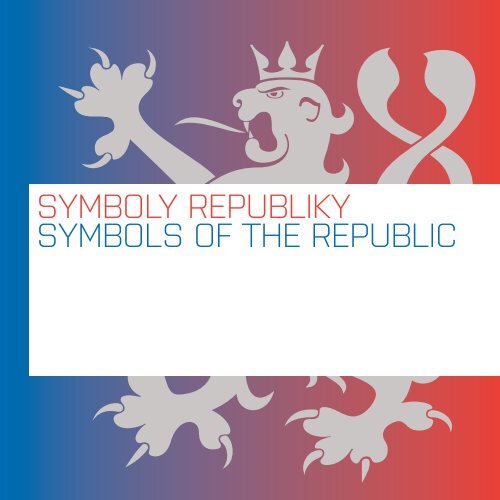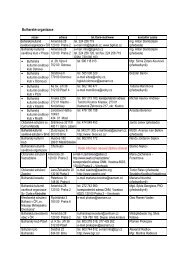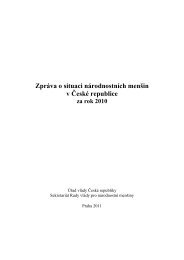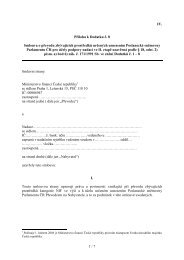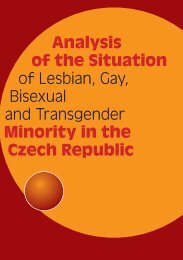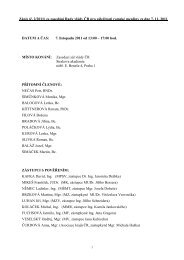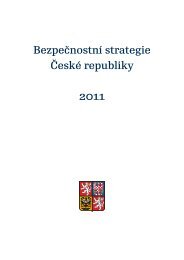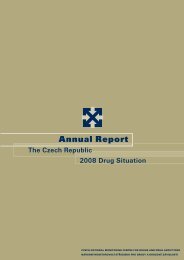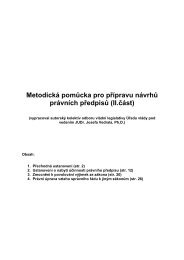Symboly republiky SymbolS of the republic - Vláda ÄR
Symboly republiky SymbolS of the republic - Vláda ÄR
Symboly republiky SymbolS of the republic - Vláda ÄR
You also want an ePaper? Increase the reach of your titles
YUMPU automatically turns print PDFs into web optimized ePapers that Google loves.
<strong>Symboly</strong> <strong>republiky</strong>Symbols <strong>of</strong> <strong>the</strong> <strong>republic</strong>
Oficiální státní symbolika České <strong>republiky</strong>je definována ve 14. článku Ústavy z roku1992. Plní především funkce identifikačnía reprezentativní, svým způsobem všaktaké přibližuje jednotlivé etapy z více nežtisíciletých dějin státu. Připomíná historickoukontinuitu, návaznost současnosti na úsilídesítek generací předků.The <strong>of</strong>ficial state symbols <strong>of</strong> <strong>the</strong> CzechRepublic are defined in Article 14 <strong>of</strong> <strong>the</strong>Constitution from 1992. They primarilyserve <strong>the</strong> purposes <strong>of</strong> identification andrepresentation, and in certain respectsalso shed light on individual stages in <strong>the</strong>country’s history, stretching back over morethan a thousand years. These symbolsrecall historical continuity, <strong>the</strong> bond between<strong>the</strong> present and <strong>the</strong> efforts <strong>of</strong> dozens <strong>of</strong>generations <strong>of</strong> our forebears.Velký státní znakV první polovině 20. let 14. století král Jan Lucemburský použil na novépečeti čtvrcený štít, střídající dvouocasého lva v prvním a čtvrtém polise znakem Lucemburska v poli druhém a třetím. Čtvrcené znaky sizískaly oblibu, počínaje Zikmundem Lucemburským se v nich zpravidlastřídaly uherské pruhy s českým lvem. Šlo o vyjádření personálníunie obou monarchií. Po roce 1490 čtvrcený štít doplnil střední štíteks erbem panující dynastie a v případě, že král byl současně římskýmcísařem, umisťoval se celý znak na hruď dvouhlavého orla se svatozářemikolem hlav. Změna přišla až po roce 1711 za císaře Karla VI.,který užíval titulaturu španělského krále. I v české formě jeho znakutudíž musely dostat zastoupení symboly Španělska. Při té příležitostise dvouocasý lev přemístil do středního štítku na místo původněvyhrazené dynastickému erbu, které se začalo považovat za nejprestižnějšípozici.Za vlády Marie Terezie se v českém panovnickém znaku na místauprázdněná po španělských znameních dostaly heraldické symbolyMoravy a Slezska. Moravskému markrabství příslušela stříbrno‐červeně šachovaná orlice se zlatou korunou i zbrojí na modrém štítu.Její počátky spadají do doby krále Přemysla Otakara II.; nejstaršídoklad se zřetelným šachováním nese pečeť města Znojma přivěšená
k listině z roku 1272, na královské pečeti je šachování nepochybné ažza Jana Lucemburského. Slezská, na zlatém štítu znázorněná černákorunovaná orlice s červenou zbrojí, na hrudi se stříbrným půlměsícemzakončeným jetelovými trojlístky a uprostřed s křížkem, bylapůvodně rodovým erbem dolnoslezských větví dynastie Piastovců.Do královské symboliky ji zahrnul Jan Lucemburský a od 15. stoletíplnila roli zemského znaku pro celé Slezsko.V období 1752–1918 se často Čechy, Morava a Slezsko považovaly jenomza tři z mnoha provincií rakouské monarchie a užší vzájemné vazbymezi nimi byly popírány. Česká politika proto zareagovala používánímaliančního znaku, složeného z trojice štítů s dvouocasým lvem,moravskou a slezskou orlicí, jejž rakouské úřady během první světovéválky zakazovaly jako útok na integritu císařství. Stal se základem tzv.legionářského znaku, rozšířeného o slovenský štít s patriarším křížema zelené lipové lístky. Po vzniku Československa nemohl oblíbenýlegionářský alianční emblém převzít roli velkého znaku, protože byvyvolával dojem nedostatečné vnitřní soudržnosti <strong>republiky</strong>. Zákonze 30. 3. 1920 tudíž zavedl střední státní znak, který z něho vycházel –obsahoval v předním štítu dvouocasého lva a ve čtvrceném zadnímštítu zemské znaky Slovenska, Podkarpatské Rusi, Moravy a Slezska,a monumentální velký státní znak. Ten zadní štít rozšířil o trojicidolních polí se znaky Těšínska, Opavska a Ratibořska, navíc doplnildva zlaté lvy coby štítonoše, lipové ratolesti a stuhu s heslem „Pravvelkýznak České<strong>republiky</strong> / greatcoat <strong>of</strong> arms<strong>of</strong> <strong>the</strong> CzechRepublic
In <strong>the</strong> first half <strong>of</strong> <strong>the</strong> 14th century, on his new seal King John <strong>of</strong>Luxembourg used a quartered shield, alternating a two-tailed lion inquarters 1 and 4 with <strong>the</strong> arms <strong>of</strong> Luxembourg in quarters 2 and 3.Quartered shields became popular; starting with Sigismund <strong>of</strong> Luxembourg<strong>the</strong>re was a tendency for <strong>the</strong> Hungarian bars to alternate with<strong>the</strong> Bohemian lion. This expressed <strong>the</strong> personal union between <strong>the</strong>two monarchies. After 1490, <strong>the</strong> quartered shield was complementedwith an inescutcheon containing <strong>the</strong> coat-<strong>of</strong>-arms <strong>of</strong> <strong>the</strong> ruling house;if <strong>the</strong> king also happened to be <strong>the</strong> Roman Emperor, <strong>the</strong> whole heraldicemblem was mounted on <strong>the</strong> breast <strong>of</strong> a two-headed eagle withhalos around its heads. This situation did not change until after 1711,during <strong>the</strong> reign <strong>of</strong> Emperor Charles VI, who used <strong>the</strong> title <strong>of</strong> King <strong>of</strong>Spain. Therefore, <strong>the</strong> symbols <strong>of</strong> Spain had to be represented in <strong>the</strong>Bohemian form <strong>of</strong> his arms. On this occasion, <strong>the</strong> two-tailed lion wasrepositioned in <strong>the</strong> inescutcheon in <strong>the</strong> place originally reserved for<strong>the</strong> coat <strong>of</strong> arms <strong>of</strong> <strong>the</strong> current dynasty, which began to be viewed as<strong>the</strong> most prestigious position.Under <strong>the</strong> reign <strong>of</strong> Maria Theresia, <strong>the</strong> space vacated by <strong>the</strong> devices<strong>of</strong> Spain in <strong>the</strong> Czech monarch’s arms was filled by <strong>the</strong> heraldicsymbols <strong>of</strong> Moravia and Silesia. The Margraviate <strong>of</strong> Moravia was repstředníznak z roku 1920 /medium coat <strong>of</strong> arms from 1920Great state coat <strong>of</strong> armsda vítězí“. Socialistická ústava z 11. 7. 1960 velký i střední státní znakzrušila. Velký se znovu prosadil, tentokrát jako český, díky ústavnímuzákonu z 13. 3. 1990. Rozhodně nenavazuje na někdejší velký znakČeskoslovenska; v prvním i čtvrtém poli má dvouocasého lva, druhépole patří moravské a třetí slezské orlici. Vnějškově může připomínatčtvrcený štít krále Jana Lucemburského, ale jakoukoli přesnou analogiiv minulosti postrádá. Jeho podoba odráží situaci, která existovalapo pádu komunistického režimu začátkem 90. let 20. století, a inspiracilze hledat ve znaku Velké Británie.
esented by a silver and red chequered eagle with a golden crownand armour on a blue shield. Its origins can be traced to <strong>the</strong> reign<strong>of</strong> Přemysl Otakar II. The oldest evidence <strong>of</strong> <strong>the</strong> Moravian eagle withclear chequering exists in a seal <strong>of</strong> <strong>the</strong> city <strong>of</strong> Znojmo attached toa document from 1272; that <strong>the</strong> chequering exists on <strong>the</strong> royal sealonly becomes undisputed under <strong>the</strong> reign <strong>of</strong> John <strong>of</strong> Luxembourg.The Silesian black crowned eagle with red armour on a golden shield,bearing on its breast a silver crescent rounded <strong>of</strong>f with three-leafedclovers and with a cross in <strong>the</strong> middle (‘clover stalk’), was originally<strong>the</strong> dynastic coat-<strong>of</strong>-arms <strong>of</strong> <strong>the</strong> Lower Silesian branch <strong>of</strong> <strong>the</strong> Piasts. Itwas incorporated into <strong>the</strong> royal symbols by John <strong>of</strong> Luxembourg, andas <strong>of</strong> <strong>the</strong> 15th century played <strong>the</strong> role <strong>of</strong> <strong>the</strong> provincial arms for <strong>the</strong>whole <strong>of</strong> Silesia.In <strong>the</strong> period from 1752 to 1918, Bohemia, Moravia and Silesia weremerely considered three <strong>of</strong> <strong>the</strong> many provinces <strong>of</strong> <strong>the</strong> Austrian monarchy,and closer mutual ties between <strong>the</strong>m were ignored. Czech politicalrepresentatives responded by using an ‘alliance emblem’ composed<strong>of</strong> three shields with a two-tailed lion and <strong>the</strong> Moravian andSilesian eagles, which was banned by <strong>the</strong> Austrian authorities during<strong>the</strong> First World War as an affront to imperial integrity. It formed <strong>the</strong>basis for <strong>the</strong> ‘legionnaires’ badge’, expanded to incorporate a Slovakshield with <strong>the</strong> patriarchal cross and green linden leaves. After <strong>the</strong>formation <strong>of</strong> Czechoslovakia, <strong>the</strong> popular legionnaires’ badge wasvelký znak z roku 1920 / great coat <strong>of</strong> arms from 1920not in a position to take over <strong>the</strong> role <strong>of</strong> <strong>the</strong> great state coat <strong>of</strong> armsbecause this would have given <strong>the</strong> impression <strong>of</strong> a certain absence<strong>of</strong> cohesion within <strong>the</strong> <strong>republic</strong>. To reflect this, <strong>the</strong> Act <strong>of</strong> 30 March1920 introduced a medium coat <strong>of</strong> arms based on <strong>the</strong> legionnaires’badge, containing a front shield with a two-tailed lion and, on <strong>the</strong>main quartered shield, <strong>the</strong> provincial arms <strong>of</strong> Slovakia, Carpathian
Ru<strong>the</strong>nia, Moravia and Silesia, and a monumental great state coat <strong>of</strong>arms. This great arms expanded <strong>the</strong> main shield to include three lowerfields for <strong>the</strong> arms <strong>of</strong> <strong>the</strong> Těšín, Opava and Ratiboř districts, andalso incorporated two golden lions as supporters, linden branchesand a scroll with <strong>the</strong> motto ‘Truth prevails’. The Socialist Constitution<strong>of</strong> 11 July 1960 abolished both <strong>the</strong> great and <strong>the</strong> medium arms. Thegreat coat <strong>of</strong> arms was revived, this time as <strong>the</strong> Czech arms, under<strong>the</strong> Constitutional Act <strong>of</strong> 13 March 1990. By no stretch <strong>of</strong> <strong>the</strong> imaginationcould it be dubbed a likeness <strong>of</strong> <strong>the</strong> erstwhile great coat <strong>of</strong> arms<strong>of</strong> Czechoslovakia; <strong>the</strong>re is a two-tailed lion in <strong>the</strong> first and fourthquarters, a Moravian eagle in <strong>the</strong> second quarter, and a Silesian eaglein <strong>the</strong> third quarter. There is a resemblance to <strong>the</strong> quartered shield <strong>of</strong>John <strong>of</strong> Luxembourg, but <strong>the</strong> heraldic emblem is devoid <strong>of</strong> any preciseanalogy with <strong>the</strong> past. Its design reflects <strong>the</strong> situation existing after<strong>the</strong> demise <strong>of</strong> <strong>the</strong> Communist regime at <strong>the</strong> start <strong>of</strong> <strong>the</strong> 1990s, and <strong>the</strong>source <strong>of</strong> inspiration was <strong>the</strong> coat <strong>of</strong> arms <strong>of</strong> <strong>the</strong> United Kingdom.Malý státní znakNejstarší znak odpovídající heraldickým pravidlům se na pečeti českéhopanovníka objevil v roce 1192; byl jím štít s orlicí, který zůstal královskýmsymbolem až do roku 1253. Když si v roce 1247 pořídil následníktrůnu a moravský markrabě Přemysl Otakar II. svou první pečeť,dal na ni vyrýt štít s dvouocasým lvem. Když se stal 23. 9. 1253 králem,znak s korunovaným stříbrným dvouocasým lvem na červeném štítusi ponechal. Od té doby až dodnes je hlavním heraldickým symbolemčeských panovníků a posléze státu. Během zmatků po násilné smrtiPřemysla Otakara II. si královský znak přivlastnila česká šlechta; proprozatímníznak z roku 1919 /provisional coat <strong>of</strong> arms from 1919
střednictvím její samosprávy se znamení dvouocasého lva stalo navíctaké zemským symbolem Čech.Vládní nařízení z 19. 5. 1919 ustanovilo prozatímní znak Československé<strong>republiky</strong>, shodný s malým znakem starého českého státu.U Slováků ale vyvolalo nesouhlas, proto malý státní znak z 30. 3. 1920dostal podobu dvouocasého lva nesoucího na hrudi srdeční štítek seznakem Slovenska. V roce 1960 byl uzákoněn jednotný státní znakČSSR ve tvaru pavézy se lvem bez koruny a s rudou pěticípou hvězdou.Po pádu komunistického režimu se 13. 3. 1990 vrátil tradiční dvouocasýlev jako malý státní znak České <strong>republiky</strong>. Má zlatou korunu, jazyki drápy, ale stříbrně znázorněné zuby.malý znak České<strong>republiky</strong> / smallcoat <strong>of</strong> arms <strong>of</strong> <strong>the</strong>Czech Republic
Small state coat <strong>of</strong> armsThe oldest arms complying with <strong>the</strong> rules <strong>of</strong> heraldry appeared on<strong>the</strong> Bohemian monarch’s seal in 1192; this was a shield with an eagle,which remained <strong>the</strong> royal symbol until 1253. When, in 1247, <strong>the</strong> heirto <strong>the</strong> throne and Margrave <strong>of</strong> Moravia Přemysl Otakar II procuredhis first seal, he incorporated a shield with a two-tailed lion into it. Hebecame king on 23 September 1253, but kept <strong>the</strong> arms with a crownedsilver two-tailed lion on a red shield. Since <strong>the</strong>n, it has been <strong>the</strong> principalheraldic symbol <strong>of</strong> Bohemian monarchs and, ultimately, <strong>of</strong> <strong>the</strong>state. In <strong>the</strong> confusion following <strong>the</strong> violent death <strong>of</strong> Přemysl OtakarII, <strong>the</strong> royal coat <strong>of</strong> arms was usurped by <strong>the</strong> Bohemian nobility;through <strong>the</strong>ir self-government <strong>the</strong> device <strong>of</strong> <strong>the</strong> two-tailed lion alsobecame <strong>the</strong> provincial symbol <strong>of</strong> Bohemia.A government regulation <strong>of</strong> 19 May 1919 established <strong>the</strong> provisionalarms <strong>of</strong> <strong>the</strong> Czechoslovak Republic, which was <strong>the</strong> same as <strong>the</strong> smallarms <strong>of</strong> <strong>the</strong> old Czech state. However, this sparked Slovak opposition,and <strong>the</strong> small arms <strong>of</strong> 30 March 1920 thus took <strong>the</strong> form <strong>of</strong> a two-tailedlion bearing an inescutcheon on its breast with <strong>the</strong> arms <strong>of</strong> Slovakia.In 1960, <strong>the</strong> single state coat <strong>of</strong> arms <strong>of</strong> <strong>the</strong> Czechoslovak SocialistRepublic was established in <strong>the</strong> form <strong>of</strong> a long-shield bearing anuncrowned lion, with a red five-pointed star. After <strong>the</strong> demise <strong>of</strong> <strong>the</strong>Communist regime, <strong>the</strong> traditional two-tailed lion made a comebackon 13 March 1990 as <strong>the</strong> small state coat <strong>of</strong> arms <strong>of</strong> <strong>the</strong> Czech Republic.It has a golden crown, tongue and claws, but silver teeth.malý znak z roku 1920 / small coat <strong>of</strong> arms from 1920
Státní barvyPodle pravidel heraldiky se <strong>of</strong>iciální barvy odvozují od znaku tak, žeprestižně první z nich odpovídá barvě erbovního znamení a druhábarvě štítu, přičemž je samozřejmě přípustné nahrazování zlaté žlutoua stříbrné bílou. V českém případě šlo od roku 1253 o bílou a červenou.Československá ústava k nim 29. 2. 1920 připojila v pořadí třetíbarvu, modrou. Tím se zabránilo totožnosti se státními barvamiRakouska a Polska, modrá má mimo jiné významnou pozici ve znakuMoravy. Oficiální české barvy nacházejí uplatnění i na stuhách státníchzáslužných řádů, původní bílá a červená přísluší k Řádu bíléholva, zřízenému 7. 12. 1922; bílá, červená a modrá se vážou k mladšímuŘádu Tomáše Garrigua Masaryka z 2. 10. 1990. Současná podoba obouřádů existuje od 9. 7. 1994.trikolora ve státních barvách / tricolour in <strong>the</strong> state colours
State coloursStátní vlajkaAccording to <strong>the</strong> rules <strong>of</strong> heraldry, <strong>the</strong> <strong>of</strong>ficial colours are derived from<strong>the</strong> arms; in terms <strong>of</strong> prestige, <strong>the</strong> primary colour is that <strong>of</strong> <strong>the</strong> charge<strong>of</strong> <strong>the</strong> coat <strong>of</strong> arms and <strong>the</strong> secondary colour is that <strong>of</strong> <strong>the</strong> shield, with<strong>the</strong> obvious proviso that gold can be replaced by yellow and silverby white. In <strong>the</strong> Czech case, since 1253 <strong>the</strong>se colours have been whiteand red. On 29 February 1920, <strong>the</strong> Czechoslovak Constitution addeda third colour, blue. This distinguished <strong>the</strong> state colours from those <strong>of</strong>Austria and Poland; moreover, blue occupies a significant place in <strong>the</strong>arms <strong>of</strong> Moravia. The <strong>of</strong>ficial Czech colours are also used on <strong>the</strong> ribbons<strong>of</strong> state orders <strong>of</strong> merit. The original white and red are used for<strong>the</strong> Order <strong>of</strong> <strong>the</strong> White Lion, established on 7 December 1922. White,red and blue ribbons are attached to <strong>the</strong> younger Order <strong>of</strong> TomášGarrigue Masaryk <strong>of</strong> 2 October 1990. The current versions <strong>of</strong> <strong>the</strong> twoorders have existed since 9 July 1994.Během první poloviny 19. století se po Čechách všeobecně rozšířilyzemské prapory a vlajky zhotovené z horního bílého a dolního červenéhopruhu. Po revoluci v roce 1848 získaly všeobecně akceptovanývýznam českého národního symbolu. Stejnou podobu měla původníčeskoslovenská vlajka, poprvé slavnostně vztyčená 18. 10. 1918, v denpublikování Washingtonské deklarace, na domě obývaném T. G.Masarykem. Po rozšíření počtu československých barev o modrou semusela změnit i vlajka. Především estetické důvody vedly k vytvořenínávrhu modrého žerďového klínu, jenž měl sahat do třetiny délkydosavadní bíločervené vlajky, ale po četných protestech byl prodloužendo její poloviny. V této podobě zákonodárci 30. 3. 1920 novou vlajkus poměrem délky k šířce 3: 2 schválili a jako státní symbol České<strong>republiky</strong> platí dodnes.československá vlajka z roku 1918 /Czechoslovak flag from 1918
State flagDuring <strong>the</strong> first half <strong>of</strong> <strong>the</strong> 19th century, provincial banners and flagswith an upper white stripe and lower red stripe became widespreadin Bohemia. After <strong>the</strong> 1848 revolution, <strong>the</strong>y were universally acceptedas a Czech national symbol. The original Czechoslovak flag, firstceremoniously raised on 18 October 1918 – on <strong>the</strong> date on which <strong>the</strong>Washington Declaration was published – at <strong>the</strong> building occupied byT. G. Masaryk, had <strong>the</strong> same appearance. After blue became one <strong>of</strong> <strong>the</strong>Czechoslovak colours, <strong>the</strong> flag had to be changed. It was primarily foraes<strong>the</strong>tic reasons that a blue wedge on <strong>the</strong> flagstaff side was designed;originally, it was meant to reach to a third <strong>of</strong> <strong>the</strong> way along <strong>the</strong> existingred and white flag, but in <strong>the</strong> wake <strong>of</strong> numerous protests it wasextended to <strong>the</strong> halfway point. Legislators approved this design <strong>of</strong> <strong>the</strong>new flag, with a length-to-width ratio <strong>of</strong> 3 : 2, on 30 March 1920, and itis still a state symbol <strong>of</strong> <strong>the</strong> Czech Republic.státní vlajka České <strong>republiky</strong> / state flag <strong>of</strong> <strong>the</strong> Czech Republic
Vlajka prezidenta <strong>republiky</strong>Tradice zvláštní vlajky pro hlavu státu sahá ve střední Evropě jendo 19. století. Roku 1828 vznikla rakouská císařská vlajka čtvercovéhotvaru s okrajem z barevných trojúhelníků. Pro československéhoprezidenta byla 30. 3. 1920 uzákoněna bílá čtvercová vlajka s okrajemve státních barvách, tvořeným místo trojúhelníků plaménky. Znázorňovalavelký státní znak. Zákon ze 17. 11. 1960 podobu prezidentskévlajky změnil: socialistický znak na ní doprovodily zlaté lipové ratolestia červená stuha s heslem „Pravda vítězí“. Vlajku prezidenta České<strong>republiky</strong> zakotvuje zákon ze 17. 12. 1992, platný od 1. 1. následujícíhoroku. Také na ní doplňují velký státní znak lipové ratolesti a tradičníheslo „Pravda vítězí“.vlajka prezidenta České <strong>republiky</strong> / flag <strong>of</strong> <strong>the</strong> President <strong>of</strong> <strong>the</strong> Czech Republic
Flag <strong>of</strong> <strong>the</strong> President <strong>of</strong> <strong>the</strong> RepublicStátní pečeťThe tradition <strong>of</strong> a special flag for <strong>the</strong> head <strong>of</strong> state only dates back to<strong>the</strong> 19th century in Central Europe; <strong>the</strong> Austrian imperial flag, squarein shape with colour triangles along <strong>the</strong> edge, was created in 1828. On30 March 1920, a white square flag, with state colours along <strong>the</strong> edge,formed by flames instead <strong>of</strong> triangles, was enshrined in law as <strong>the</strong> flag<strong>of</strong> <strong>the</strong> Czechoslovak president. It depicted <strong>the</strong> great state coat <strong>of</strong> arms.The Act <strong>of</strong> 17 November 1960 altered <strong>the</strong> appearance <strong>of</strong> <strong>the</strong> presidentialflag; <strong>the</strong> socialist heraldic emblem was accompanied by goldenlinden branches and a red scroll with <strong>the</strong> motto ‘Truth prevails’. Theflag <strong>of</strong> <strong>the</strong> President <strong>of</strong> <strong>the</strong> Czech Republic was appointed in a law <strong>of</strong> 17December 1992, which entered into force on 1 January <strong>of</strong> <strong>the</strong> followingyear. Here, <strong>the</strong> great state coat <strong>of</strong> arms is complemented with lindenbranches and <strong>the</strong> traditional motto ‘Truth prevails’.Nejstarší státní pečeť v dnešním slova smyslu nechali pořídit v roce1432 přestavitelé vítězných husitů v rámci příprav na diplomatickájednání s cizinou. Zobrazovala štít s dvouocasým lvem a latinský opisji označoval jako pečeť Koruny království českého, což byl tehdejší<strong>of</strong>iciální název státu. Uplatňovala se do roku 1458. Štít s dvouocasýmlvem byl také na první pečeti Československa užívané do roku1924, která postrádala jakýkoli opis. Tu nahradily velká a malá pečeť<strong>republiky</strong> podle zákona z 30. 3. 1920. Od roku 1960 existovala jedinástátní pečeť, zobrazující státní znak doplněný z obou stran lipovýmiratolestmi o třech listech. Později se měnil název <strong>republiky</strong> v opisua podoba znaku, současná pečeť s velkým znakem České <strong>republiky</strong>pochází z roku 1990.vlajka prezidenta z roku 1920 / presidential flag from 1920 státní pečeť z roku 1432 / state seal from 1432
State sealThe oldest state seal, in today’s sense <strong>of</strong> <strong>the</strong> word, was procured in 1432by representatives <strong>of</strong> <strong>the</strong> victorious Hussites in <strong>the</strong>ir preparations fordiplomatic talks with o<strong>the</strong>r countries. It depicted a shield with a twotailedlion and <strong>the</strong> Latin legend termed it <strong>the</strong> seal <strong>of</strong> <strong>the</strong> Crown <strong>of</strong> <strong>the</strong>Kingdom <strong>of</strong> Bohemia, which was <strong>the</strong>n <strong>the</strong> <strong>of</strong>ficial name <strong>of</strong> <strong>the</strong> state. Itwas used until 1458. The shield with a two-tailed lion was also appliedto <strong>the</strong> first seal <strong>of</strong> Czechoslovakia, used until 1924; this seal bore nolegend. It was replaced by great and small seals <strong>of</strong> <strong>the</strong> <strong>republic</strong> under<strong>the</strong> Act <strong>of</strong> 30 March 1920. As <strong>of</strong> 1960, <strong>the</strong>re was only one state seal,depicting <strong>the</strong> state coat <strong>of</strong> arms complemented on <strong>the</strong> sides by lindenbranches with three leaves each. The name <strong>of</strong> <strong>the</strong> <strong>republic</strong> and <strong>the</strong>arms were subsequently changed; <strong>the</strong> current seal, containing <strong>the</strong>great coat <strong>of</strong> arms <strong>of</strong> <strong>the</strong> Czech Republic, comes from 1990.státní pečeť České <strong>republiky</strong> / state seal <strong>of</strong> <strong>the</strong> Czech Republic
Státní hymnaOd konce 18. století se v Evropě začaly prosazovat moderní hymnybez náboženského významu. V pražském Stavovském divadle zazněla21. 12. 1834 při premiéře hry Fidlovačka poprvé píseň „Kde domov můj“,složená Františkem Škroupem na slova Josefa Kajetána Tyla. Po páduabsolutistického režimu v bouřlivých 60. letech 19. století se prosadilajako ne<strong>of</strong>iciální česká národní hymna. V Československu nařídilo 13.12. 1918 ministerstvo obrany hrát spolu s českou hymnou vždy i slovenskou„Nad Tatrou sa blýska“; 5. 12. 1930 vydala vláda usnesení, že oběpísně tvoří nedílnou československou hymnu. Ústavní zákon z 13. 3.1990 prohlásil první sloku písně „Kde domov můj“ za státní hymnuČeské <strong>republiky</strong>.česká národní hymna / Czech national an<strong>the</strong>m
National an<strong>the</strong>mModern an<strong>the</strong>ms free <strong>of</strong> religious meaning began to emerge in Europefrom <strong>the</strong> end <strong>of</strong> <strong>the</strong> 18th century. On 21 December 1834 in <strong>the</strong> EstatesTheatre in Prague, <strong>the</strong> song ‘Kde domov můj’ (‘Where is my home?’),composed by František Škroup to words by Josef Kajetán Tyl, was firs<strong>the</strong>ard during <strong>the</strong> premiere <strong>of</strong> <strong>the</strong> play Fidlovačka (Spring Festival).After <strong>the</strong> demise <strong>of</strong> <strong>the</strong> absolutist regime in <strong>the</strong> stormy 1860s, it establisheditself as <strong>the</strong> un<strong>of</strong>ficial Czech national an<strong>the</strong>m. In Czechoslovakia,on 13 December 1918 <strong>the</strong> Ministry <strong>of</strong> National Defence ordered that<strong>the</strong> Czech an<strong>the</strong>m always be played toge<strong>the</strong>r with <strong>the</strong> Slovak an<strong>the</strong>m,‘Lightning over <strong>the</strong> Tatras’, and on 5 December 1930 <strong>the</strong> governmentissued a resolution declaring that <strong>the</strong> two songs constituted <strong>the</strong> integralCzechoslovak an<strong>the</strong>m. Under <strong>the</strong> Constitutional Act <strong>of</strong> 13 March1990, <strong>the</strong> first verse <strong>of</strong> ‘Where is my home?’ was declared as <strong>the</strong> nationalan<strong>the</strong>m <strong>of</strong> <strong>the</strong> Czech Republic.Vydáno ve spolupráci s Národním muzeem, Národním archivem, Archivem Poslanecké sněmovnyParlamentu ČR a Kanceláří prezidenta <strong>republiky</strong>Published in association with <strong>the</strong> National Museum, <strong>the</strong> National Archives, <strong>the</strong> Archive <strong>of</strong> <strong>the</strong> Chamber<strong>of</strong> Deputies <strong>of</strong> <strong>the</strong> Parliament <strong>of</strong> <strong>the</strong> Czech Republic, and <strong>the</strong> Office <strong>of</strong> <strong>the</strong> President <strong>of</strong> <strong>the</strong> RepublicAutor / Author: Pavel SedláčekGrafická úprava / Graphic Design: Filip Blažek, Studio Designiq© Úřad vlády České <strong>republiky</strong>, 2007© Office <strong>of</strong> <strong>the</strong> Government <strong>of</strong> <strong>the</strong> Czech Republic, 2007


